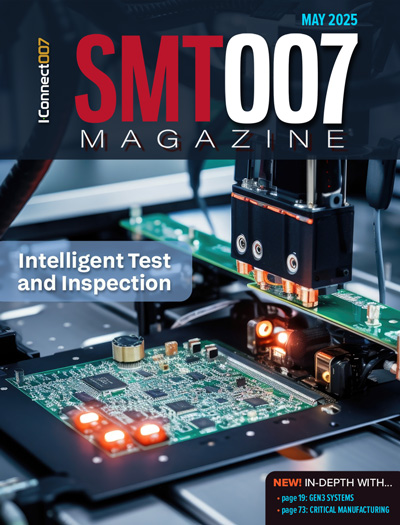-

-
News
News Highlights
- Books
Featured Books
- smt007 Magazine
Latest Issues
Current Issue
What's Your Sweet Spot?
Are you in a niche that’s growing or shrinking? Is it time to reassess and refocus? We spotlight companies thriving by redefining or reinforcing their niche. What are their insights?

Moving Forward With Confidence
In this issue, we focus on sales and quoting, workforce training, new IPC leadership in the U.S. and Canada, the effects of tariffs, CFX standards, and much more—all designed to provide perspective as you move through the cloud bank of today's shifting economic market.

Intelligent Test and Inspection
Are you ready to explore the cutting-edge advancements shaping the electronics manufacturing industry? The May 2025 issue of SMT007 Magazine is packed with insights, innovations, and expert perspectives that you won’t want to miss.
- Articles
- Columns
- Links
- Media kit
||| MENU - smt007 Magazine
The Root Causes & Solutions for Warped PC Boards
September 27, 2017 | Duane Benson, Screaming CircuitsEstimated reading time: 2 minutes
So, you just got a nice big PCB back from the fab shop. You set one on your desk to admire, only to discover that it's warped. What do you do?
There are two primary types of causes of board warping: process related at the fab or assembly shop, and layout related issues.
If it's warped before assembly, it's between fab and layout. If it's flat before assembly and warped after, it's most likely between layout and assembly. That said, sometimes a fab problem won't show up until a pass through the reflow oven at your assembly partner.
Determining the root cause is generally a bit of an iterative process. It's tempting to start right off with your fab or assembly partner, but you need some information before giving them a call. You'll need such things as the amount of warpage per inch, board size and thickness. With that, you need to take a good look at your design and consider copper pours, component size and component placement.
With that information in hand, you can make your phone call. If the board is warped before assembly, call your fab shop. If it's flat pre-assembly and warped post assembly, call your assembly house.
The shop you call will want to talk over your design to help you pinpoint the cause. If you can rule out a design issue, then you need to talk with your partner to determine whether it's a fab or assembly issue, and the next steps to take care of you.
Here are a few design issues that could contribute to warping:
- Uneven copper pour: Copper and FR-4 are a good match relative to thermal expansion, but they aren't exact. A large pour on one side or corner of your board can lead to warping due to dissimilar expansion characteristics. This could cause warpage either at the fab shop or the assembly house.
- Thermal mass: Components with large thermal mass grouped together on the board. This would be more likely to cause problems during assembly than during fab. The thermal mass will act as a heat sink for that area on the board, which can lead to uneven expansion and uneven soldering.
- Thin boards: A board that's too thin for the size or number of components could lead to warping at any stage.
- Irregular shapes: Odd shapes or large cutouts could also lead to warping at any point.
There may be other, more obscure causes, but those are the main design related causes. If it's none of those, talk with your partner. Occasionally, design requirements lead to a board that is essentially non-manufacturable. Hopefully, you never have this situation, but if you do, make sure that thickness, component location, pours, or cut outs really need to be the way they are.
If you absolutely, positively can't change anything, go back and try again. Then you can to look for heroic means to get the board fabricated and built. Slight warpage might go away when the board is mounted. Just be careful. Some components may not stay securely soldered when you flatten it.
The board may need a special fixture during assembly to prevent warping. This will likely cost extra, but if you can't change your design, and still need it built, it may be your best option.
Finally, if nothing works, you may need to look harder at the design, or look for a new fab or assembly house. We all like to think we can do just about anything, but every shop has its limits, and on rare occasion, those limits can be difficult to spot.
Suggested Items
Copper Price Surge Raises Alarms for Electronics
07/15/2025 | Global Electronics Association Advocacy and Government Relations TeamThe copper market is experiencing major turbulence in the wake of U.S. President Donald Trump’s announcement of a 50% tariff on imported copper effective Aug. 1. Recent news reports, including from the New York Times, sent U.S. copper futures soaring to record highs, climbing nearly 13% in a single day as manufacturers braced for supply shocks and surging costs.
I-Connect007 Editor’s Choice: Five Must-Reads for the Week
07/11/2025 | Andy Shaughnessy, Design007 MagazineThis week, we have quite a variety of news items and articles for you. News continues to stream out of Washington, D.C., with tariffs rearing their controversial head again. Because these tariffs are targeted at overseas copper manufacturers, this news has a direct effect on our industry.I-Connect007 Editor’s Choice: Five Must-Reads for the Week
Digital Twin Concept in Copper Electroplating Process Performance
07/11/2025 | Aga Franczak, Robrecht Belis, Elsyca N.V.PCB manufacturing involves transforming a design into a physical board while meeting specific requirements. Understanding these design specifications is crucial, as they directly impact the PCB's fabrication process, performance, and yield rate. One key design specification is copper thieving—the addition of “dummy” pads across the surface that are plated along with the features designed on the outer layers. The purpose of the process is to provide a uniform distribution of copper across the outer layers to make the plating current density and plating in the holes more uniform.
Trump Copper Tariffs Spark Concern
07/10/2025 | I-Connect007 Editorial TeamPresident Donald Trump stated on July 8 that he plans to impose a 50% tariff on copper imports, sparking concern in a global industry whose output is critical to electric vehicles, military hardware, semiconductors, and a wide range of consumer goods. According to Yahoo Finance, copper futures climbed over 2% following tariff confirmation.
Happy’s Tech Talk #40: Factors in PTH Reliability—Hole Voids
07/09/2025 | Happy Holden -- Column: Happy’s Tech TalkWhen we consider via reliability, the major contributing factors are typically processing deviations. These can be subtle and not always visible. One particularly insightful column was by Mike Carano, “Causes of Plating Voids, Pre-electroless Copper,” where he outlined some of the possible causes of hole defects for both plated through-hole (PTH) and blind vias.


